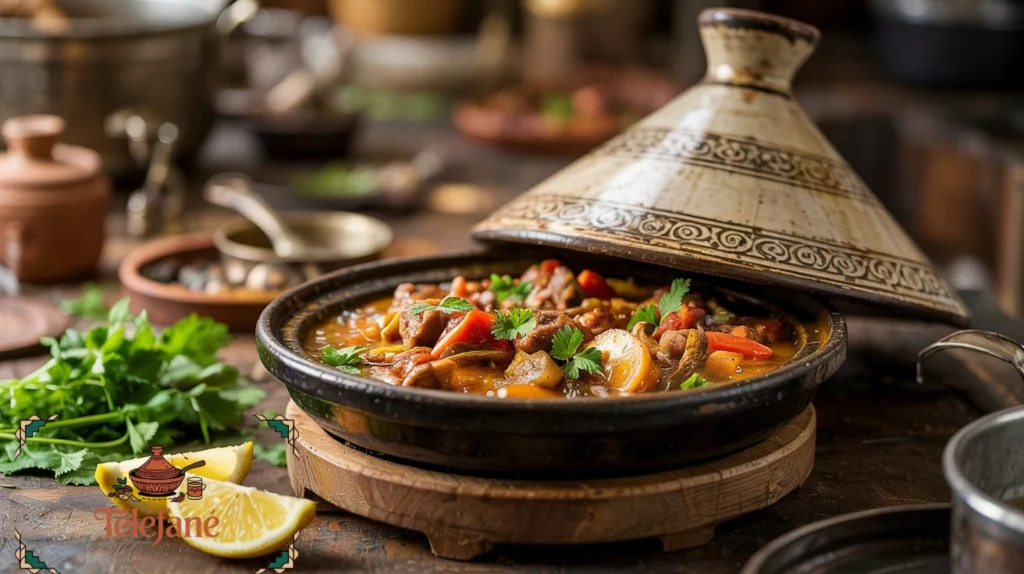How to Make Moroccan Tagine: A Step-by-Step Guide to Perfecting This Iconic Dish
Moroccan Tagine is one of the most iconic dishes in Moroccan cuisine, known for its unique blend of aromatic spices, tender meat, and slow-cooked vegetables. Named after the earthenware pot in which it is traditionally cooked, the tagine is not only a dish but a cooking technique that imparts deep flavors and tenderness to whatever is placed inside it. In this article, we’ll walk you through how to make a traditional Moroccan tagine at home, guiding you with ingredients, preparation steps, and cooking techniques that will bring the authentic taste of Morocco right to your kitchen.
What Is a Tagine?
A tagine refers to both the dish and the cooking vessel used to prepare it. The pot, typically made from clay or ceramic, has a conical lid that helps to retain moisture during the slow-cooking process, creating tender, flavorful dishes. Tagines are often cooked over a low flame for several hours, allowing the ingredients to meld together and absorb the aromatic spices.
While the term “tagine” is often associated with meat dishes like lamb or chicken, the possibilities are endless. You can create a variety of tagine recipes with different combinations of meats, vegetables, and fruits, resulting in a rich and diverse culinary experience.
Essential Ingredients for Moroccan Tagine
To make a traditional Moroccan tagine, you’ll need a few key ingredients, many of which are staple items in Moroccan cooking:
- Meat: Traditionally, lamb or chicken are the most common choices, though beef, goat, and even fish are also used in some regions of Morocco.
- Vegetables: Root vegetables like carrots, potatoes, and sweet potatoes, as well as zucchini, tomatoes, and bell peppers, are commonly used.
- Dried fruits: Apricots, raisins, or prunes add a sweet and tangy contrast to the savory flavors.
- Spices: A blend of aromatic spices is what truly defines Moroccan tagine. Common spices include cumin, coriander, ginger, saffron, turmeric, and cinnamon. Ras El Hanout, a spice mix that includes a variety of spices such as cardamom, paprika, and allspice, is often added for extra complexity.
- Olive oil: A key ingredient in Moroccan cooking, providing richness and flavor.
- Garlic and onions: These create the base for the tagine’s flavor.
- Fresh herbs: Cilantro and parsley are often used as garnishes or added toward the end of cooking for a fresh burst of flavor.
Step-by-Step Guide to Making Moroccan Tagine
Now, let’s dive into the steps for creating this mouthwatering dish.
Step 1: Choose Your Meat
Begin by selecting your preferred meat. If you’re using lamb, consider bone-in cuts for extra flavor, like shoulder or shank. For chicken, bone-in thighs or a whole chicken cut into pieces work well. Make sure to cut the meat into pieces that will fit comfortably in your tagine pot.
Step 2: Season the Meat
In a large bowl, combine the meat with a blend of spices. For a basic Moroccan seasoning, use cumin, coriander, paprika, ginger, turmeric, cinnamon, and salt. Rub the spices into the meat, making sure it’s evenly coated. You can also marinate the meat for a few hours or overnight to let the flavors deepen.
Step 3: Sauté Onions and Garlic
Heat a few tablespoons of olive oil in your tagine pot or a large Dutch oven over medium heat. Add chopped onions and sauté them until they soften and become golden, about 5 minutes. Add the garlic and cook for another minute, releasing its fragrance.
Step 4: Brown the Meat
Add the seasoned meat to the pot and brown it on all sides. This step adds flavor and color to the meat. Depending on the size of your pot, you might need to do this in batches. Don’t rush this step—it’s crucial for building the flavor foundation of the dish.
Step 5: Add Vegetables and Dried Fruits
Once the meat is browned, add your chopped vegetables. Common choices are carrots, sweet potatoes, zucchini, and tomatoes. You can also add dried fruits like apricots, raisins, or prunes for a touch of sweetness.
Step 6: Add Liquid and Simmer
Pour in chicken stock or water to create a flavorful base for the sauce. The liquid should just cover the meat and vegetables. Bring the mixture to a simmer, and once it’s bubbling, reduce the heat to low.
Cover the tagine with its lid, or use a tight-fitting lid for a Dutch oven, and let it cook for 1.5 to 2 hours, stirring occasionally. The goal is to let the meat become tender and the flavors blend together.
Step 7: Garnish and Serve
When the tagine is ready, remove it from the heat and garnish it with fresh cilantro and parsley. If you’d like, you can also add a handful of toasted almonds or olives for extra flavor and texture.
Tips for Making the Perfect Moroccan Tagine
- Low and Slow: The beauty of tagine cooking is its slow pace. Allow the dish to simmer gently, ensuring the meat becomes tender and the flavors meld together.
- Experiment with Ingredients: While lamb and chicken are the most popular, feel free to experiment with beef, fish, or even a vegetarian tagine. The versatile base allows you to create different variations.
- Tagine Pot: If you’re cooking in a traditional tagine pot, make sure to soak it in water for 30 minutes before using it to prevent cracking due to temperature changes.
Why You Should Make Moroccan Tagine at Home
Making Moroccan tagine at home allows you to experience the rich flavors of Morocco without the need for a trip abroad. By incorporating aromatic spices, tender meats, and fresh vegetables, Moroccan tagine is not only a treat for your taste buds but also an invitation to immerse yourself in one of the most celebrated cuisines in the world.



